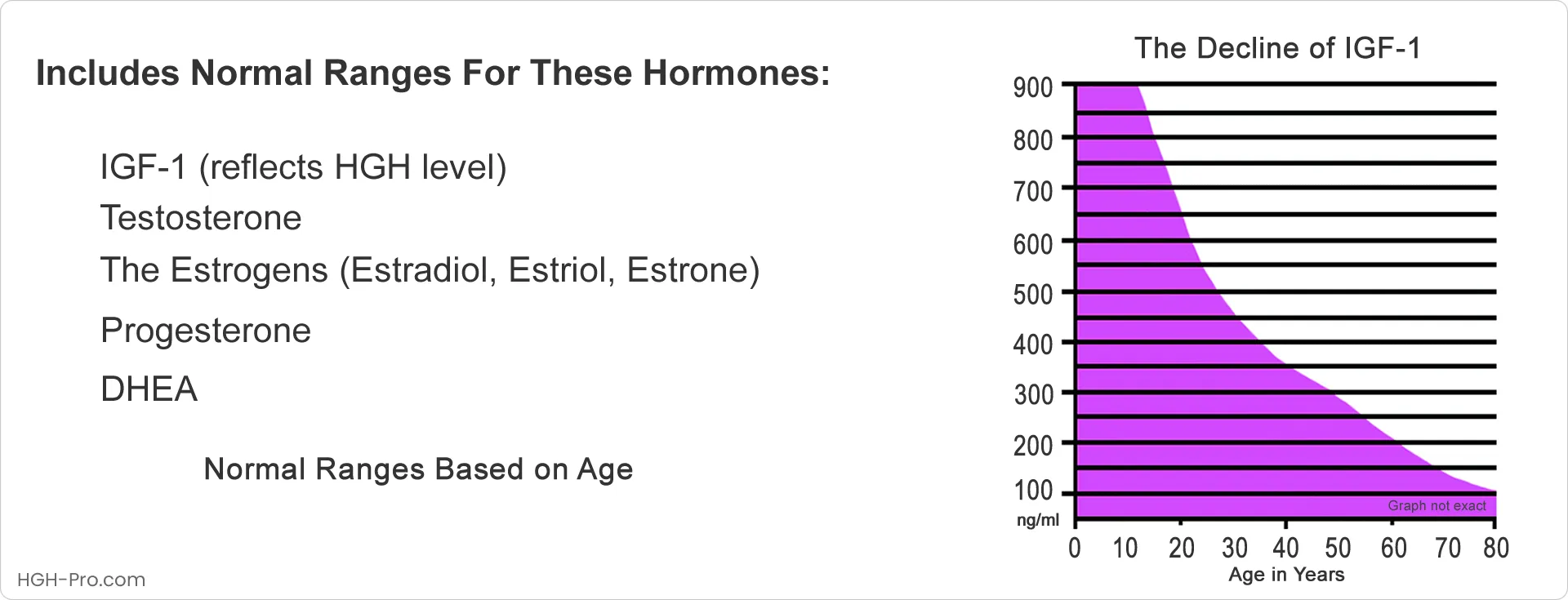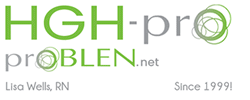Normal Hormone Levels Based on Age
By Lisa Wells, RN

Below are listed the normal blood levels of IGF-1, testosterone, the estrogens, estradiol, estriol, estrone, progesterone, and DHEA.
Please note, all hormones decrease with age so most of the levels listed below are what modern Western medicine considers normal for age. This means they take into account the fact that without intervention the hormone levels in the body will continue to decline with age. Of course the decrease of these important hormones as we age plays a major role in the effects of aging.
Rather than focus on what is generally considered normal for age we in anti-aging and functional medicine focus more on the hormone levels that are required in order for the body of each individual patient to function optimally. Many times this means having a blood test level that is at the mid to high end of the normal ranges below.
IGF-1 Levels Used For Checking Growth Hormone
Once released by the pituitary gland human growth hormone remains in the bloodstream for only a few minutes before being taken in by the liver. For this reason measuring an accurate HGH blood level requires an involved and time consuming stimulation test that has certain risk factors.
Because IGF-1 (insulin-like growth factor - 1) is released in response to growth hormone and remains stable in the bloodstream longer it is the test normally used for checking HGH in adults.
Blood Tests to Check HGH and Diagnose GH Deficiency
| IGF-1 Levels (Somatomedin C) - BLOOD | ||
| Age | Males - ng/ml | Females - ng/ml |
| 2 months - 5 years | 17 - 248 | 17 - 248 |
| 6 - 8 years | 88 - 474 | 88 - 474 |
| 9 - 11 years | 110 - 565 | 117 - 771 |
| 12 - 15 years | 202 - 957 | 261 - 1096 |
| 16 - 24 years | 182 - 780 | 182 - 780 |
| 25 - 39 years | 114 - 492 | 114 - 492 |
| 40 - 54 years | 90 - 360 | 90 - 360 |
| > 55 years | 71 - 290 | 71 - 290 |
| Testosterone (Total) | |||
| Males | ZRT Lab Reference Range - SALIVA | Males | Reference Range - BLOOD |
| Age | pg/ml | Age | ng/dL |
| All Ages | 44 - 148 | 20 - 30 | 280 - 1205 |
| 16 - 30 | 72 - 148 | 30 - 40 | 350 - 1010 |
| 31 - 50 | 58 - 120 | 40 - 50 | 255 - 1025 |
| 51 - 70 | 44 - 94 | 50 - 60 | 255 - 950 |
| > 70 | 30 - 77 | 60 - 70 | 120 - 870 |
| 70 - 80 | 38 - 850 | ||
| 80 - 90 | 28 - 390 | ||
| Females | Reference Range - BLOOD | ||
| Age | ng/dL | ||
| Adults | 15 - 70 | ||
| Estradiol | |||
| Females | ZRT Lab Reference Range - pg/ml - SALIVA | ||
| Premenopausal | 1.3 - 3.3 | ||
| Postmenopausal | 0.5 - 1.7 | ||
| Males | ZRT Lab Reference Range - pg/ml - SALIVA | ||
| 0.5 - 2.2 | |||
| Females | Quest Diagnostics Reference Range - pg/ml - BLOOD | ||
| Untreated Postmenopausal | < 31 | ||
| Treated Postmenopausal | < 94 | ||
| Oral Contraceptives | < 103 | ||
| Ovulating, Follicular | < 161 | ||
| Ovulating, Follicular 2 to 3 days | < 85 | ||
| Ovulating, Peri-ovulatory +/- 3 days | < 34 - 400 | ||
| Ovulating, Luteal | 27 - 246 | ||
| Estriol | |
| Females | ZRT Lab Reference Range - pg/ml - SALIVA |
| Premenopausal | < 7 |
| Postmenopausal | < 7 |
| Males | ZRT Lab Reference Range - pg/ml - SALIVA |
| 0 - 3 | |
| Estrone | |
| Females | ZRT Lab Reference Range - pg/ml - SALIVA |
| 1.6 - 5 | |
| Males | ZRT Lab Reference Range - pg/ml - SALIVA |
| 0 - 3 | |
| Estrogens | |
| Females - BLOOD | Reference Range - pmol/l |
| Prepubertal | 12 - 57 |
| Follicular Phase | 29 - 525 |
| Luteal Phase | 126 - 478 |
| Postmenopausal | 23 - 103 |
| Males - BLOOD | |
| Prepubertal | 12 - 55 |
| Adult | 38 - 139 |
| Progesterone | |||
| Females | ZRT Lab Range - pg/ml - SALIVA | ng/ml - BLOOD | pmol/l - BLOOD |
| Luteal Phase | 75 - 270 | 4 - 20 | 11.6 - 58 |
| Follicular Phase | 12 - 100 | 0.3 - 0.8 | 0.9 - 2.3 |
| Postmenopausal | 12 - 100 | ||
| Males | ZRT Lab Range - pg/ml - SALIVA | ng/ml - BLOOD | pmol/l - BLOOD |
| 15 - 100 | 0.12 - 0.3 | 0.3 - 0.9 | |
| Females | Quest Diagnostics Range - ng/ml - BLOOD | Females | ng/ml - BLOOD |
| = or > 18 Years Old | Pregnancy | ||
| Follicular Phase | < 1.0 | 1st Trimester | 4.1 - 34.0 |
| Luteal Phase | 2.6 - 21.5 | 2nd Trimester | 24.0 - 76.0 |
| Postmenopausal | < 0.5 | 3rd Trimester | 52.0 - 302.0 |
Below you will see two tables of values for DHEA sulfate. The first shows the difference in what modern medicine considers normal for age and what functional and anti-aging medicine considers optimal for bodily function. The 2nd table shows a breakdown of what the U.S. NIH considers normal. Notice the wide range in the values of the NIH and the difference in the standard and optimal ranges.
| DHEA-S - BLOOD | |||
| Standard Range ug/dL | Optimum Range ug/dL | ||
| Males | 280 - 640 | 400 - 500 | |
| Females | 65 - 380 | 350 - 430 | |
| DHEA-S - BLOOD | ||
| National Institute of Health | ||
| Age | Males | Females |
| Standard Range ug/dL | Standard Range ug/dL | |
| 18 - 19 | 108 - 441 ug/dL | 145 - 395 ug/dL |
| 20 - 29 | 280 - 640 | 65 - 380 |
| 30 - 39 | 120 - 520 | 45 - 270 |
| 40 - 49 | 95 - 530 | 32 - 240 |
| 50 - 59 | 70 - 310 | 26 - 200 |
| 60 - 69 | 42 - 290 | 13 - 130 |
| 69 + | 28 - 175 | 17 - 90 |
Please note: The reference ranges at different labs may vary and may be different than the ranges posted here. Your own lab report should show the correct normal ranges for your specific tests. Please consult your private healthcare provider.
Other Hormonal Articles of Interest
Can Women Receive Estrogen and Progesterone Benefits Without the Risks?
Human Growth Hormone and the Aging Process
The Importance of Proper Adrenal Function and Balanced Cortisol
Hypothyroidism - The Undiagnosed and Treatment Failures
Important Hormones That Decrease With Age
More Articles About HGH and Health Conditions, Anti-Aging, Etc., by Lisa Wells, RN
Bibliography
Clemmons, D. Clinical utility of measurements of insulin-like growth factor 1. Nat Rev Endocrinol 2, 436-446 (2006). doi: 10.1038/ncpendmet0244



